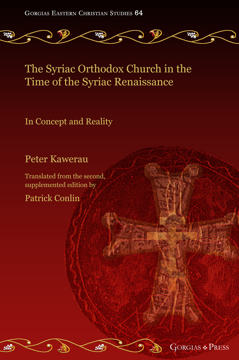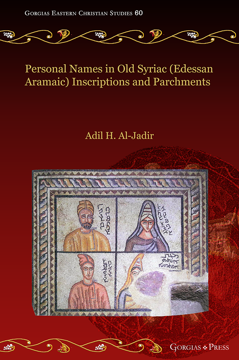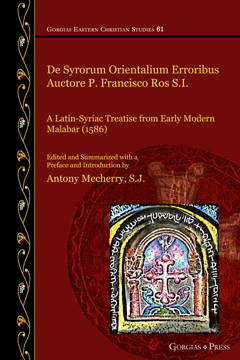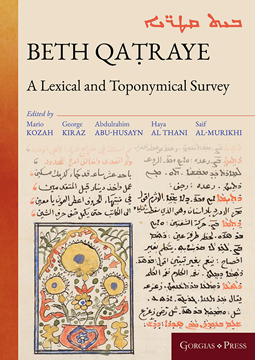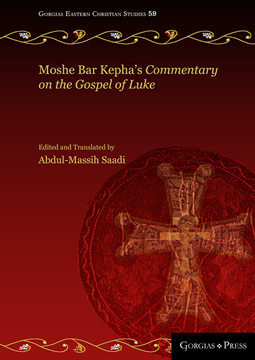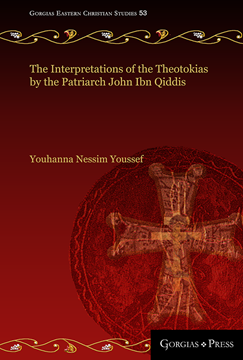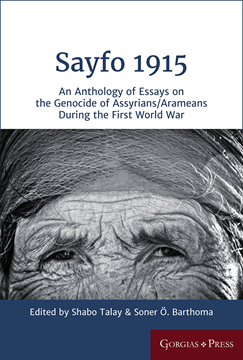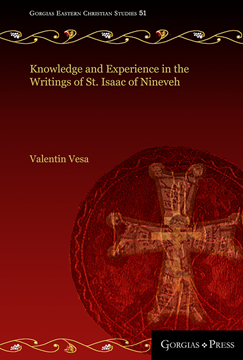Gorgias Eastern Christian Studies
Gorgias Eastern Christian Studies brings to the scholarly world the underrepresented field of Eastern Christianity. This series consists of monographs, edited collections, texts and translations of the documents of Eastern Christianity, as well as studies of topics relevant to the world of historic Orthodoxy and early Christianity.
Rediscovery of a Lost History of Central Asian Christianity
Historical Context and Archaeological Evidence
By Kevin White
Series: Gorgias Eastern Christian Studies 74
ISBN: 978-1-4632-4984-7
A comprehensive survey of archaeological finds related to Syro-Aramaic Christianity in Kazakhstan and Central Asia, examining Soviet and modern Russian-language archaeological reports, analyzing the observations and conclusions of Soviet and modern archaeologists. This work features over 200 photographs and illustrations related to Syro-Aramaic Christian finds, as well as providing extensive Russian-language bibliographical information, and maps providing the location of sites where evidence of Christianity has been discovered.
$114.95 (USD) $91.96 (USD)
Orthodox Choreographies
Boundaries, Borders and Materiality in Jerusalem's Old City
Series: Gorgias Eastern Christian Studies 69
ISBN: 978-1-4632-4625-9
The book offers a comprehensive anthropological study of lived Christianity in Jerusalem’s Old City, with a special focus on the Church of the Holy Sepulchre or the Church of the Anastasis. Based on in-depth ethnographic fieldwork, the study explores the experiences of the Rum Orthodox community, examining their internal dynamics and relationships with other Christian groups. Within the Church of the Anastasis, complex interplays emerge, as fragile legal agreements intermingle with ethnic and theological considerations, resulting in a complex reality of shared spaces and coexistence. A materialist lens is employed to study these dynamics, suggesting that the material aspects of religious practices play a crucial role in shaping borders and influencing perceptions of similarities and differences across them. Outside the Church's confines, in the Old City of Jerusalem, lay Christians, especially the local Palestinian Orthodox, engage in 'border-crossing practices', which often deviate from the Orthodox Church's approved practice. These practices reflect the flexible strategies local Christians adopt in their everyday lives in Israel, challenging established norms and boundaries. By capturing these dynamics, the book provides valuable insights into shared sacred spaces and offers a significant contribution to debates in the anthropology of Christianity and its material culture.
$134.95 (USD) $107.96 (USD)
Le combat spirituel chez Isaac de Ninive
By Paul Matar
Series: Gorgias Eastern Christian Studies 68
ISBN: 978-1-4632-4623-5
Pourquoi Isaac de Ninive ? Et pourquoi le thème du combat chez lui aujourd’hui ? Nous avons essayé de donner par la figure d’Isaac un remède efficace aux problèmes de notre monde qui est assujetti aux nouvelles technologies, au bruit, à la consommation, à la guerre, à l'égoïsme, etc. Remède composé d’armes avec lesquelles nous pouvons construire et ne jamais détruire, surtout avec l’arme de la miséricorde. À travers ce livre, nous avons noté que les problèmes de l’homme du troisième millénaire ne sont pas seulement sociaux, économiques, politiques et psychologiques, mais aussi spirituels.
$114.95 (USD) $91.96 (USD)
The Collection of Wardā
A Contextual and Christological Analysis
By Dahlia Khay Azeez, Dahlia Khay Azeez, Dahlia Khay Azeez, Dahlia Khay Azeez, Dahlia Khay Azeez & Dahlia Khay Azeez
Series: Gorgias Eastern Christian Studies 70
ISBN: 978-1-4632-4589-4
A study of twenty hymns from the collection of liturgical hymns known as the “Book of Wardā” – hymns attributed to a poet from the thirteenth century named Gīwargīs Wardā. The hymns of this book are chanted during the liturgy of the Assyrian Church of the East, Ancient Church of the East, and the Chaldean Church. A critical edition and translation is given for each poem, and the book includes a commentary on the themes expressed in the poems.
$114.95 (USD) $91.96 (USD)
Celebrating the Holy Saints
The Origin, Evolution, and Liturgical Use of the Mälkəʿ
Series: Gorgias Eastern Christian Studies 67
ISBN: 978-1-4632-4557-3
This book explores the somatic hymns – Mälkəʿ – addressed to saints in the Ethiopian and Eritrean Churches, their origin and development, and transmission and use in the present day. This vast and hitherto untapped collection of hymns are an important source for an accurate understanding of the Church’s spirituality, hagiography, and liturgy.
$95.00 (USD) $76.00 (USD)
Mfaḥmono Kashiro
Perspectives on the Syriac Bible in Honor of Andreas Juckel
Edited by George Anton Kiraz & Hannah Stork
Series: Gorgias Eastern Christian Studies 71
ISBN: 978-1-4632-4738-6
In celebration of Andreas Juckel's seminal contributions to the field of Syriac studies and biblical scholarship, Mfaḥmono Kashiro offers a compelling tapestry of research and insight. Edited by George A Kiraz and Hannah Stork, this Festschrift honors Juckel on his 70th birthday, bringing together a diverse range of papers from leading scholars in the field.
$95.00 (USD) $76.00 (USD)
Sacred Space in Syriac Orthodox Liturgy
A Ritual and Theological Perspective
Series: Gorgias Eastern Christian Studies 66
ISBN: 978-1-4632-4555-9
A study of how the Sedrō of Entrance has been practiced in earlier periods and architectural contexts and to investigate what role the entrance rite may have had in constructing the sanctuary as sacred space and the worshipping community as church.
$95.00 (USD) $76.00 (USD)
Šalmūtā Šapīrtā
Festschrift for Rifaat Y. Ebied in honour of his contributions to Semitic Studies
Edited by Erica C. D. Hunter
Series: Gorgias Eastern Christian Studies 65
ISBN: 978-1-4632-4541-2
A Festschrift for Rifaat Ebied celebrating a lifetime of work in the field of Semitic Studies, in particular Syriac, Christian Arabic, and Mandaic.
$140.00 (USD) $112.00 (USD)
The Syriac Orthodox Church in the Time of the Syriac Renaissance
In Concept and Reality
By Peter Kawerau; Translated by Patrick Conlin
Series: Gorgias Eastern Christian Studies 64
ISBN: 978-1-4632-4467-5
An English translation of the second edition of Peter Kawerau's Die Jakobitische Kirche im Zeitalter der syrischen Renaissance (1960).
$65.00 (USD)
ʿAmmār al-Baṣrī's Arabic Apologetics
The Book of the Proof concerning the Course of the Divine Economy and The Book of Questions and Answers
Translated by Mark Beaumont
Series: Gorgias Eastern Christian Studies 63
ISBN: 978-1-4632-4458-3
A new English translation of the two apologetic works by the 9th-century East Syrian theologian ʿAmmār al-Baṣrī. The Book of the Proof and The Book of Questions and Answers were written to defend Christian beliefs in the face of Muslim criticism.
$60.00 (USD) $48.00 (USD)
The Theology of ‘Ammār al-Basrī
Commending Christianity within Islamic Culture
Series: Gorgias Eastern Christian Studies 62
ISBN: 978-1-4632-4361-6
ʿAmmār al-Baṣrī (d.c. 850) was the first Christian to write a systematic theology in Arabic, the language of the Muslim rulers of ʿAmmār’s Middle East. This study of his two works that were only discovered in the 1970’s seeks to analyse the way he defends Christian beliefs from criticism by Muslims over the authenticity of the Gospels, the Trinity, the divinity of Christ, the Incarnation, the death of Christ by crucifixion, the resurrection of Christ, and the nature of the afterlife. ʿAmmār al-Baṣrī wrote his theology in dialogue with Muslim thinkers of his time and his work offers guidance to Christians in today’s world who live in Islamic contexts in how to relate Christian convictions to a Muslim audience.
$114.95 (USD)
Personal Names in Old Syriac (Edessan Aramaic) Inscriptions and Parchments
Series: Gorgias Eastern Christian Studies 60
ISBN: 978-1-4632-4249-7
This book collects systematically all the personal names found in Old Syriac sources in such a way as to enable them to be dealt with from a structural and lexical point of view and compared with other corpora of Aramaic personal names as well as Hebrew and Arabic names. As far as possible, the personal names of the new finds of unpublished inscriptions discovered recently are included. Thus, this study covers all the personal names which are found in the Syriac corpus so far. The book fills a significant gap in scholarship, since there are dedicated works on Palmyrene, Hatran and Nabataean personal names, but no such work exists for early Syriac (i.e. pre-Christian Syriac) personal names.
$114.95 (USD)
De Syrorum Orientalium Erroribus, Auctore P. Francisco Ros S.I.
A Latin-Syriac Treatise from Early Modern Malabar (1586)
Edited and Summarized with a Preface and Introduction by Antony Mecherry, S.J.
Series: Gorgias Eastern Christian Studies 61
ISBN: 978-1-4632-4353-1
In the present work, De Syrorum Orientalium Erroribus, Auctore P. Francisco Ros S.I.: A Latin-Syriac Treatise from Early Modern Malabar (1586), Antony Mecherry S.J. brings to the fore a recently identified sixteenth-century treatise on ‘Nestorianism’ written by Francisco Ros S.J. (1559–1624), a Catalonian from the Jesuit province of Aragón, who successfully promoted the mission praxis of accommodatio primarily among the Saint Thomas Christians of early modern Malabar in South India. This newly discovered first treatise composed by Ros, a Latin missionary, represents the initial phase of his mission as a polemicist in the making, who read the Syriac sources of the Church of the East found in Malabar, through a Catholic theological lens. In addition to exploring the underlying conflicts emerged out of an unprecedented encounter of apparently unlike theological and liturgical identities in the same mission field of early modern India, this book provides the readers with a historiographical critique against the backdrop of which the author presents his analysis of the Rosian treatise.
$55.00 (USD)
Beth Qaṭraye
A Lexical and Toponymical Survey
By Dr Mario Kozah, George Anton Kiraz, Prof Abdulrahim Abu-Husayn, Haya Al Thani & Saif Shaheen Al-Murikhi
Series: Gorgias Eastern Christian Studies 58
ISBN: 978-1-4632-4139-1
This volume presents and analyzes information on the pre-Islamic and early Islamic historical geography and toponyms of the Beth Qaṭraye region as well as newly discovered vocabulary from a language referred to as Qaṭrāyīth (“in Qatari”) used by its inhabitants.
$55.00 (USD)
Moshe Bar Kepha's Commentary on the Gospel of Luke
Edited and Translated by Abdul-Massih Saadi
Series: Gorgias Eastern Christian Studies 59
ISBN: 978-1-4632-4221-3
Moshe Bar Kepha was a prolific writer of the ninth century. His writings reflect various aspects of West Syriac theology and ecclesiology, and his literary legacy links the earlier Syriac exegetical tradition (beginning with Ephrem) with the Syriac 'Renaissance' of the eleventh to thirteenth centuries. His use of sources crosses Christian confessional boundaries in such a way that his works are tinged with aspects of Syriac exegesis from both East and West Syriac traditions. In his Commentary on Luke, the Muslim-dominated context in which Moshe lived is clearly evident in the background, and his aim is to fortify the credibility of the Christian faith and the validity of Christian doctrines for his readers.
$156.00 (USD)
The Interpretations of the Theotokias by the Patriarch John ibn Qiddis
Series: Gorgias Eastern Christian Studies 53
ISBN: 978-1-4632-3948-0
The theotokias are prayers dedicated to the Virgin Mary, the Mother of God (Theotokos). In the early fourteenth century, the Patriarch of the Coptic Church, Ibn Qiddis, composed and paraphrased – in Coptic – the Theotokias. His work has only survived in a single manuscript. This book introduces the author, John Ibn Qiddis, his liturgical, pastoral, and literary activities, and the Coptic language of his time, followed by the texts and an English translation.
$135.00 (USD) $108.00 (USD)
Jewish Cultural Elements in the Ethiopian Orthodox Täwaḥədo Church
Series: Gorgias Eastern Christian Studies 55
ISBN: 978-1-4632-0717-5
This monograph traces how ‘Jewish’ elements were introduced into and disseminated throughout the Ethiopian Orthodox Täwaḥədo Church through a series of multi-layered, socio-politico-cultural processes. Drawing on historical and literary evidence, Afework tracks the incorporation of Jewish features into the Ethiopian Orthodox Church from pre-Aksumite Christianity, before the fourth century, through the sixteenth century.
$118.00 (USD)
"And from his side came blood and milk"
The Martyrdom of St Philotheus of Antioch in Coptic Egypt and Beyond
Series: Gorgias Eastern Christian Studies 52
ISBN: 978-1-4632-3916-9
This book examines the function and development of the cult of saints in Coptic Egypt, focusing primarily on the material provided by the texts forming the Coptic hagiographical tradition of the early Christian martyr Philotheus of Antioch, and more specifically, the Martyrdom of St Philotheus of Antioch (Pierpont Morgan M583). This Martyrdom is a reflection of a once flourishing cult which is attested in Egypt by rich textual and material evidence. This text enjoyed great popularity not only in Egypt, but also in other countries of the Christian East, since his dossier includes texts in Coptic, Georgian, Ethiopic, and Arabic.
$114.95 (USD)
An Early Christian Reaction to Islam
Išū‘yahb III and the Muslim Arabs
Series: Gorgias Eastern Christian Studies 57
ISBN: 978-1-4632-4098-1
The year 652 marked a fundamental political change in the Middle East and the surrounding region. An important and contemporary source of the state of the Christian Church at this time is to be found in the correspondence of the patriarch of the Church of the East, Išū‘yahb III (649–659), which he wrote between 628 and 658. This books discusses Išū‘yahb’s view of and attitudes toward the Muslim Arabs.
$134.00 (USD)
History of Eastern Christianity (paperback)
Series: Gorgias Eastern Christian Studies 16
ISBN: 978-1-4632-4115-5
This book is a classic in the history of the Oriental Churches, which are sometimes portrayed as heretical in general church history books, if mentioned at all. Written by a Copt, it portrays the history of the faith of these non-Chalcedonian Churches with first-hand knowledge of their traditions. The author covers Alexandrine Christianity (the Copts and the Ethiopians), the Church of Antioch (Syriac Orthodox), the “Nestorian” Church of the East, the Armenian Church, the St. Thomas Christians of South India, the Maronite Church, as well as the Vanished Churches of Carthage, Pentapolis, and Nubia.
$110.00 (USD)
The Mystical Tradition of the Eastern Church
Studies in Patristics, Liturgy, and Practice
Edited by Sergey Trostyanskiy & Jess Gilbert
Series: Gorgias Eastern Christian Studies 56
ISBN: 978-1-4632-4060-8
This volume presents the work of contemporary Orthodox thinkers who attempt to integrate the theological and the mystical. Exciting and provocative chapters treat a wide variety of mysticism, including early Church accounts, patristics (including the seemingly ever-popular subject of deification), liturgy, iconography, spiritual practice, and contemporary efforts to find mystical sense in cyber-technologies and post-humanism.
$114.95 (USD)
The Syriac Tradition of the Infancy Gospel of Thomas (paperback)
A Critical Edition and English Translation
By Tony Burke
Series: Gorgias Eastern Christian Studies 48
ISBN: 978-1-4632-4091-2
A long-awaited and essential tool for the study of one of the earliest texts of the Christian Apocrypha and an important text in Syriac literature, theology, and history.
$89.00 (USD)
Sermon on Saint Thomas, the Beloved Apostle
A Syriac Catholic Panegyric from Seventeenth Century Malabar
Translation and Introduction by Radu Mustaţă
Series: Gorgias Eastern Christian Studies 54
ISBN: 978-1-4632-3902-2
A study of a homily in praise of Saint Thomas, written in Syriac by a Catholic missionary. The homily, which is preserved in two manuscripts, is an important witness to the interaction between the Indian Syrian Christians and the Western Catholic missionaries.
$78.65 (USD)
Sayfo 1915
An Anthology of Essays on the Genocide of Assyrians/Arameans during the First World War
Edited by Shabo Talay & Soner Ö. Barthoma
Series: Gorgias Eastern Christian Studies 50
ISBN: 978-1-4632-0730-4
Drawing on the expertise of scholars from a variety of backgrounds, this anthology specifically seeks to shed light on this genocide from a multidisciplinary perspective and serve as a step for developing the future scholarship about the Sayfo.
$95.00 (USD)
Knowledge and Experience in the Writings of St. Isaac of Nineveh
Series: Gorgias Eastern Christian Studies 51
ISBN: 978-1-4632-3905-3
One of the most popular monastic authors with a nearly universal spread over time is Isaac of Nineveh, a mystic of the late 7th century, who belonged to the East Syriac Church. This book is dedicated to the doctrine of knowledge, as described in Isaac of Nineveh’s discourses, in its double dimension, worldly/philosophical and theological (the former considered to be more discursive/intellectual and the latter intuitive/ experiential) and the rapport established between these two, prolonged in the concept of vision, as the highest form of spiritual experience.
$114.95 (USD)









